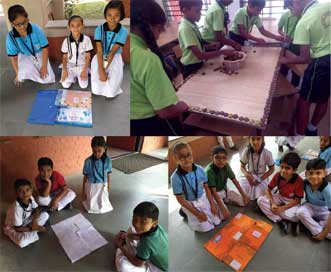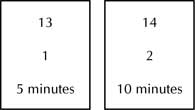Suma Vivekanandan
I have noticed that students often get confused between AREA and PERIMETER. They also make mistakes in writing the correct unit. The activity described here helped clear these two concepts for my students. This activity also helps students understand why we need a standard unit to measure and what the standard unit for area is.
Divide the class into groups of 4 to 5 students. Instruct each group to fill the inside of a tile on the floor or the table top using different objects – notebooks, newspaper, crayons or bottle caps.
After they finish ask each group how many (number) objects they used to fill up the inside of the tile or table top.
Each group will give you different answers like 20 notebooks or 10 newspapers or 100 bottle caps, etc.
Have a class discussion. Ask your students why despite the size of the tile/table top being the same, each group had a different answer.
Here you can discuss the need for a standard unit.

After this activity and class discussion, students themselves will conclude that Unit blocks can be used to measure the AREA and the unit of area is square unit.
Here you can ask them why it makes sense to use square units. Allow them to think and give answers. You may get different answers. After listening to their views, tell them that any standard must easily be “constructed” on the spot and it is not convenient to transport a standard from place to place. From this point of view a square is the easiest figure to specify as it has just the one dimension, its side! The square can also fill (tessellated) up any area without leaving any gaps!
You can also incorporate another activity to show them the difference between area and perimeter.
- Make several square cards (say the size of a chessboard square). Take the side as 1 unit and area as 1 square unit.
- Suppose you give the students 12 cards and ask them to make rectangles of different sizes. You can make a 2 X 6, a 3 X 4 or a 1 X 12 rectangle.
- Ask students – what property all these rectangles have in common (area!)
- Ask them to find the perimeter of each of these figures. They will have different perimeters. Find the one with the least perimeter and the one with the most.
- This shows that same areas can have different perimeters.
- Have classroom discussion:- If you think of these shapes as the surfaces of dining tables then
o The number of plates and dishes you can place on the table will depend on the area.
o The number of people who can sit around the table will depend on the perimeter! - Ask the students to use a thread of a given length and create different figures which will have the same perimeter but different areas.
What time is it? Being able to tell the time is an important skill that children learn in primary school. This activity described not only helps children learn to tell the time but also to convert the 12 hour format into a 24 hour one.
Start your class by asking the students why a clock displays numbers only from 1 to 12. Allow your students to brainstorm. Ask them to come up with common proverbs related to time, such as “Time and tide wait for none,” or “A stitch in time saves nine” to get them thinking about the subject.

The following activity enables students to read and write time in different ways.
This activity can be done inside or outside the classroom.
Ask 12 students to sit in a circle (like a clock) holding placards. Each card will have three numbers on it. Right on top will be time in the 24 hour format followed by time in the 12 hour format and finally time in minutes at the bottom.
- Place a shoebox (or any empty box) with time chits inside.
- The chits should have time written in all possible ways. 11:55, 5 minutes to 12, 55 minutes past 11, 5 minutes past 2, 2:05, half past 6, 18:30, etc.
- Children take turns, walk to the centre of the circle, pick up a chit from the box, read out the time and show it on the clock (that their classmates have formed) using their hands or two sticks.

These kind of activities also highlight the role of language in mathematics.
11.55 is eleven fifty five or fifty five minutes past eleven or five minutes to twelve. This is an opportunity for the teacher to talk about what the day means to the common man and to a scientist/mathematician. For the common man a day is 12 hours (the other 12 being night). So we have am and pm. For the scientist/mathematician a day is 24 hours (it is a cycle). There is no am or pm. The starting point is 12 midnight.
Learning to read time in the traditional way is important even in this digital age for it improves a child’s motor and cognitive skills besides his mathematical skills. Understanding time the traditional way is also necessary to later understand concepts like time zones and international time.
The author is a mathematics teacher and primary coordinator in Atul Vidyalaya, Atul, Gujarat. She can be reached at suma_vivekanandan@atulvidyalaya.ac.in.
